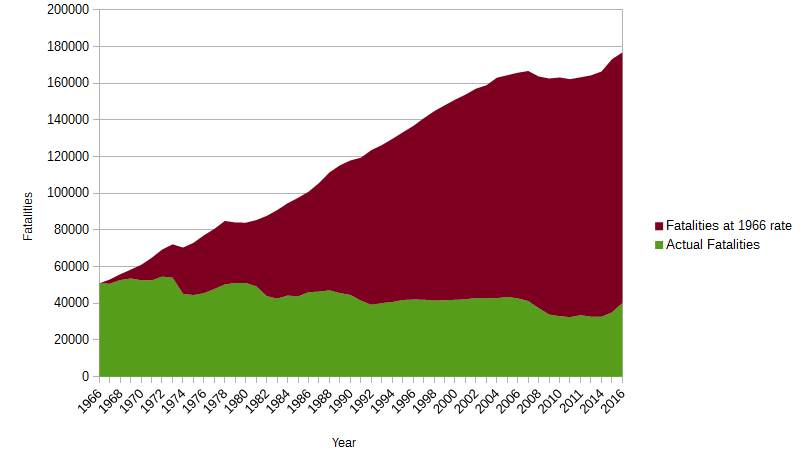In 1966, motor vehicle fatality rate in the US was 5.5 deaths per 100 million miles traveled. That year, Congress passed the Highway Safety Act, the Department of Transportation was created, and the first Federal Motor Vehicle Safety Standard was released, mandating seat belts. Over the next 51 years, cars have steadily become safer for a variety of reasons, to the point that the death rate in 2014 was 1.08 per 100 million miles. The rate has jumped the past two years; in 2016, preliminary data puts the rate at 1.25. But compared to the 5.5 rate of 1966, this is a massive improvement, one which most Americans take for granted.
How many lives have these changes saved? If you assume the death rate stayed at the 1966 level, instead of dropping, then the answer is this: 3.6 million. In 2016 alone, 177,000 people would have died, instead of the 40,000 that did. That’s 137,000 lives saved – about 374 a day,
The chart below shows the actual number of deaths (green) versus the presumed number at the 1966 rate (red). Everything in red are lives saved.

This is a massive success story, but one that is mostly ignored. Why?
- The change has happened slowly, over 50+ years. There was no single dramatic fix, just a lot of incremental changes.
- The raw numbers aren’t as compelling. On the chart above, the total deaths haven’t dropped much over the 50 years. That’s because the population of the US has grown, as has the amount we drive. “It could have been much worse” isn’t a particularly sexy statement.
- There are still a lot of deaths on the roads. The problem hasn’t been solved, just reduced. Massively reduced.
So take a step back and appreciate a major public policy success story. Almost assuredly, you or someone you know are among the 3.6 million lives saved.

I had read about this years ago, but didn’t realize the improvement was so great. Five times less deaths? That’s dramatic.